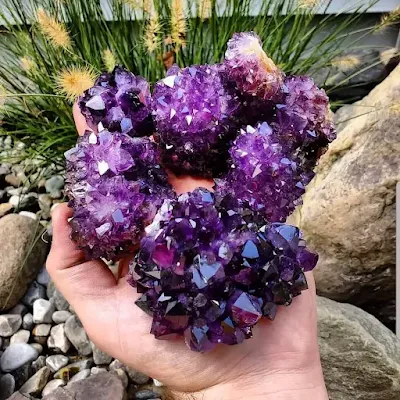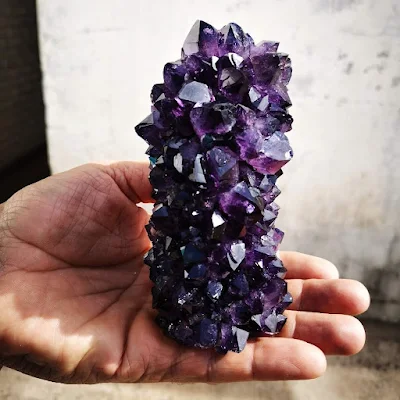What is Amethyst Stalactite
Amethyst Stalactite
Amethyst “stalactite” is a tube agate that forms in the center of an agate/amethyst vug within a hydrothermal igneous formation. It is not a limestone nor a cave formation. The agate center is formed when the chemicals and minerals in the water change as it runs through the cavity. The crystals of Amethyst then grow around the Agate.
Amethyst "stalactites" are found within amethyst geodes or vugs, hollow spaces within volcanic rock formations. These cavities form when gases escape during the cooling and solidifying of volcanic magma.
Amethyst stalactites, despite their name, are not actually stalactites in the traditional sense. While the term evokes images of mineral deposits dripping from cave ceilings, amethyst stalactites form differently and possess unique characteristics.
 |
| Amethyst Stalactites From Rio De La Plata, Artigas, Uruguay. Photos: StalactitefromUruguay/IG |
How does Amethyst stalactite form
The formation of amethyst stalactites, also known as tube agates with amethyst crystals, involves a fascinating interplay of heat, water, and minerals within volcanic rock. Here's a breakdown of the key steps:
1. Cavity Formation:
Within volcanic rock, cracks or voids form due to cooling and pressure changes. These cavities provide the space for the agate and amethyst to develop.
2. Hydrothermal Activity:
Hot, mineral-rich water circulates through the underground rock formations. This water is typically rich in silica, iron, and aluminum.
3. Agate Formation:
As the hot water cools and pressure changes within the cavity, layers of chalcedony and other minerals start to deposit. These layers build up, forming the core of the "stalactite" - the agate.
4. Amethyst Crystal Growth:
As the water continues to flow through the cavity, its chemical composition changes. Iron and aluminum concentrations increase, while silica levels might decrease.
These changes trigger the formation of amethyst crystals. Iron and aluminum combine with remaining silica to form the vibrant purple quartz crystals that we associate with amethyst.
The amethyst crystals begin to grow outwards from the inner surface of the agate core, forming the characteristic radiating pattern.
5. Stabilization and Preservation:
Over time, the water flow slows down or stops, and the cavity becomes filled with more silica or other minerals. This seals the formation and preserves the agate and amethyst.
 |
| Amethyst Stalactites from New Mine In Artigas Uruguay. Credit: Nowar Minerals Inc. |
Amethyst "stalactites" are rare geological formations, and they are only found in a few places around the world. The best known locations for amethyst "stalactites" are Uruguay, Brazil, and Morocco.
Amethyst stalactites are a beautiful and rare natural formation. They are often cut and polished into jewelry or other decorative objects.
 |
| Amethyst Stalactites |
Appearance of Amethyst Stalactites
When sliced, they reveal a captivating cross-section:
- Agate center: This core can display a variety of colors and patterns, like banded agate, moss agate, or brecciated agate.
- Amethyst layer: This outer layer consists of delicate amethyst crystals, radiating outwards from the center. The amethyst color can range from pale lavender to deep purple, and sometimes even displays zoning (variations in color within the crystals).
Color: Amethyst stalactites range from pale lavender to deep purple, often with stunning variations and banding within the crystals.
Shape: They come in various shapes and sizes, from slender tubes to bulbous clusters.
Internal structure: When sliced and polished, they showcase the mesmerizing combination of the banded agate core and the radiating amethyst crystals.
 |
| Amethyst AGATE stalactites |
Amethyst Stalactites Uses
- Jewelry: Amethyst stalactites are highly prized in jewelry making, often used for stunning cabochons, pendants, and rings. Their unique beauty and internal patterns make them truly captivating pieces.
- Decorative objects: Polished amethyst stalactites can be stunning display pieces in their own right, adding a touch of natural wonder and vibrant color to any space.
- Metaphysical uses: Some believe amethyst stalactites possess calming and grounding properties, promoting spiritual connection and inner peace.
 |
| Gorgeous amethyst stalactite from Rio de la Plata, Artigas, Uruguay. |








